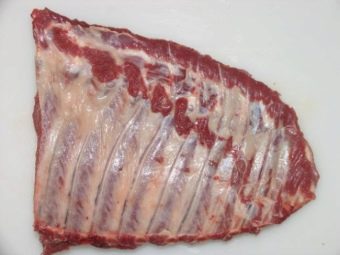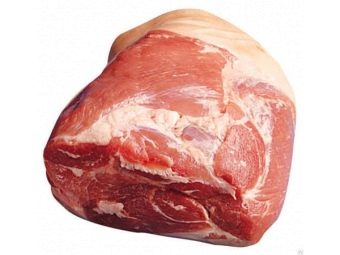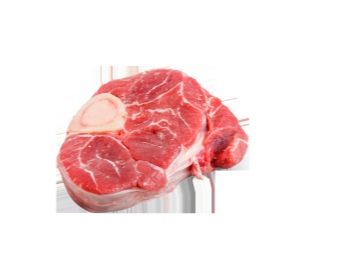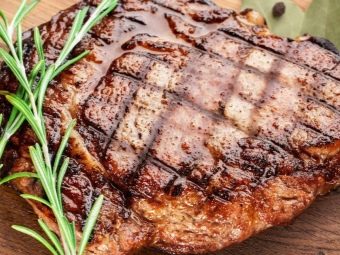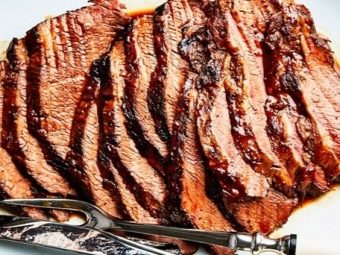Portions of beef carcass: scheme and names, recipes
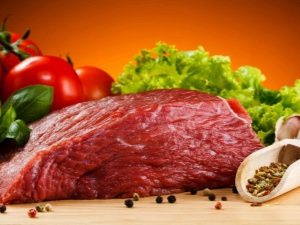
Beef is a dietary and lean meat compared to pork, therefore, is particularly popular with supporters of healthy eating. Cow meat can be used in baby food, starting from an early age baby.
But in order the meat dish is tender and tasty, the chef must understand the parts of the carcass, as each of them is suitable for a particular type of dish.
Cutting scheme
Considering the proposed product in the window, you can easily determine the purpose of a particular piece, if you know the generally accepted scheme of cutting carcasses.
Let's start in order with the head of the beef body. The head is rarely available, as it is not a complete piece of meat. However, in the villages from time immemorial, parts of the head are used to make rich soups, aspic, and are twisted for mince.
Next, we present a list of standard cuts in the form in which they are sold on the market or in stores.
- Neck. Cervical cut is also called nick. It is characterized by a large number of tendons.
- Shoulder and shoulder part. Meats of varying degrees of hardness with fat layers, depending on the location.
- Back. This part is subdivided at once into several cuts, having different purposes in cooking. Thick edge - a solid layer of meat, sometimes with leaving part of the ribs, has fine delicate fibers. The ribs on the ribs are often called the “thin edge” due to the smaller amount of meat layer compared to the thick edge.
- Ribs - peeled rib meat.
- Entrecote - soft meat remaining after cutting from the ribs.
- The lumbar portion, sirloin. It can be both on the bone and without. It is schematically divided into a thick rim - rump (meat with a small amount of fatty layers, located in the pelvic carcass) and a thin edge - tenderloin (tender meat mass, considered the most valuable and at the same time lean).
- Brisket In its intact form it represents the chest bone with ribs in the front part and the cartilaginous processes of the ribs in the back. The meat is interspersed with layers of fat and films. Can be on sale both on a bone, and without.
- Kostets. Gentle varietal meat, located in the hip part and exciting spine.
- The winder. The upper thigh of the hind leg of the animal. It has a soft structure, especially on the inside.
- Rump. The middle part of the thigh, which, in turn, is subdivided into the inner side, the probe, and the lower part, the sec.
- Pasha, or peritoneum, curl. The meat part of the abdomen and groin area. Meat rough, with fat, cartilage and films.
- Knuckle. Part of the meat from the front leg of the animal, the main content of which is the muscles, tendons and bone.
- Shin. The cerebral bone of the hind leg, which, when cooked, releases a large amount of gelatin. Also shank contains a lot of connective tissue.
What part for what to use?
Experienced chefs advise before buying a cut, first decide on the culinary purpose of this or that part. In order not to get confused in the variety of names and not to be misled, it is better to strictly follow the recipe. To do this, you need to remember or write in your culinary notebook, which use fits a specific cut of beef.
For cooking
Beef produces excellent dietary broths. For the preparation of the first dishes any bones of the carcass are suitable, as well as the trachea. For lumpy meat in the soup fit the neck cut, shoulder part, knuckle and shank. Of these, soups and broths are prepared, aspic, minced meat for cutlets.
For frying
In this case, it is best to use tender meat tenderloin, thick edge, fillet, loin. They are fried both in large portions, and cut into small pieces.
It can be a steak, roast beef, goulash, entrecote, kebab.
To extinguish
For stews, the hip and scapular parts of the cut, rump, bone, underfolds, and kidney mass are most often used.
It can also be chops, beef stroganoff, stewed kidneys.
For baking
For baking, breast, bone, tenderloin and okovalok are suitable. They make excellent roast beef in English, bacon with spices.
Quality Definition
The quality of meat is often influenced by factors that can not be determined with the naked eye - this is the sex of the animal, its age, diet and conditions of detention, and correct cutting of the carcass is also very important.
But still when choosing meat there are nuances that should not be neglected if you want to later beef dishes turned out culinary masterpieces.
- The uniform distribution of the color range of reddish hues indicates the freshness of the cut. Too dark color, leaving in brown and brown, has old meat. Too scarlet tones signal chemical additives to preserve the presentation.
- Meat should not be covered with a dense crust. If there is one, then the cut has been lying on the counter for too long. The slimy surface of the meat indicates improper storage conditions - most likely, the meat just suffocated in polyethylene.
- Bloody stains in the window under the cut are obtained in the event that the meat has been defrosted and unscrupulous seller tries to pass it off fresh chilled.
- Small pink crystals on frozen meat will also indicate that the cut is not subjected to primary freezing.
- No less important is the elasticity and elasticity of the piece - after pressing the fingers on the meat should not remain dents and pits.
On how to choose the right fresh and high-quality beef, you can see in the next video.
Meat Recipes
Despite the fact that the preparation of any meat requires certain culinary skills, there are recipes that even a novice can bring to life.
Consider several diverse recipes - hot dish, cold appetizer and dietary version of beef. The recipes are simple in execution, require not much time and products.
Ragu
This recipe is universal because with a minimum investment you get a full dinner for the whole family or a second hot meal for dinner, which does not require an additional side dish.
Ingredients.
- 1 kg of beef. Meat is better to take from cuts intended for extinguishing.
- 1.5 kg or 6-8 medium-sized potatoes.
- 0.5 broth or boiled water.
- 1 large onion head.
- 3 tbsp. spoons of vegetable oil. To enhance the taste, you can mix the sunflower and olive at the rate of 2: 1.
- Carrots - 2 pieces of medium size.
- Garlic - 2 large cloves.
- Salt, seasonings and herbs to taste.
You should prepare a deep frying pan in advance, or additionally use a stewpan.
Cooking
- Rinse the meat, dry with a paper towel, if necessary, remove the veins and bones. Cut into pieces, not too large, but not small, so that it is convenient to impale them on the fork.
- Prepare vegetables - peel the onions, carrots, garlic. If desired, a small amount of tomatoes and zucchini slices can be added to the vegetables. Vegetables are cut in an arbitrary or standard way: carrots - in small cubes, onion-half rings, zucchini - in large cubes.
- Pour oil into a frying pan or stew pan, heat the dishes well and put onion. Fry until slightly transparent state, add beef cubes. Stir for 5 minutes to redden the meat.
- Pour vegetables and spices. Continue stirring for another 5 minutes. Vegetables should grab a golden crust.
- Add bay leaf, put the potatoes, pour water or broth so that the liquid covers the potatoes.
- Bring to a boil over high heat, then reduce to minimum and simmer for 1 hour.
- Finely chopped greens can be added 5 minutes before the readiness or directly into the plate before serving the dish.
Carpaccio
This dish of Italian cuisine, related to cold appetizers, is considered to be an exquisite culinary. According to the preparation technology, it resembles a Stroganin familiar to us, but its recipe uses not beef, but beef tenderloin.
For the classic carpaccio will need the following ingredients:
- 250 g beef tenderloin;
- 1 bunch of arugula;
- 120 ml of olive oil;
- 1 tbsp. spoon of wine vinegar;
- 2 tbsp. spoons of lemon juice;
- 1/3 tsp salt.
Meat for carpaccio should choose the freshest, cooled, unfrozen earlier. Old meat of dark shades is not suitable for this dish, and young veal meat will be an ideal option.
Cooking
- Cut the rinse well and dry with a paper towel. Wrap cling film and put in the freezer for 1 hour.
- Prepare arugula and sauce. Rinse greens and allow to drain off excess moisture. In a container mix wine vinegar, lemon juice and salt.
- After an hour, get the frozen meat out of the freezer, let it soak for 2-3 minutes and start cutting. Cut into slices with a sharp thin knife. Slices should be almost transparent.
- To increase the subtlety of each piece, you can slightly beat off a culinary hammer.
- Meat is laid out on a plate in a single layer, decorated with rucola leaves and poured over the sauce.
Beef dietary
Beef meat itself is dietary, contains a lot of fiber and a minimum of fat. However, his nutritionists categorically do not recommend frying to avoid the formation of harmful cholesterol. Therefore, the diet method of cooking is stewing or boiling.
For the simplest recipe, you can choose any cut of beef, except for the brisket, because it has the greatest amount of fatty layers.
For this recipe will require:
- a piece of meat without bone;
- vegetables - carrots, onions, garlic;
- large saucepan;
- package for roasting.
- Rinse the meat well and put in the bag. Add peeled and chopped vegetables.
- Tie a baking bag around the edges with thick threads and tie it to the pot handles so that the food is completely dipped in water.
- Boil meat with vegetables for 3 hours.
The principle of cooking is a steam bath. Meat and vegetables are boiled in their own juice, which does not mix with water and does not evaporate.
Benefit and harm
- Beef is considered a dietary meat and is indicated primarily for people on a diet. The product is slowly absorbed by the body, and the feeling of hunger is significantly removed even after eating a small portion of the piece.
- Due to the fibrous structure of the beef acts on the gastrointestinal tract as fiber - removes toxins and cholesterol from the body.
- Trace elements contained in meat, help to strengthen the bone tissue, blood vessel walls, increase blood clotting.
- Beef broth is indicated for the diet of people who have undergone surgery and bone fractures.
- A large amount of protein in meat gives strength and energy to the body, activates brain activity. It is especially important to include beef meat in the diet of athletes and people engaged in physical activity.
Among the contraindications can be called the excess of the daily rate of consumption of this product. Beef, like any meat, is not an easy food, which can lead to problems with digestion, weight in the stomach, and general breakdown.







